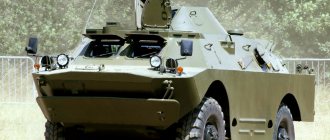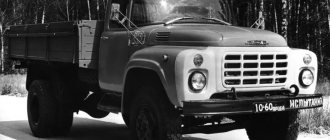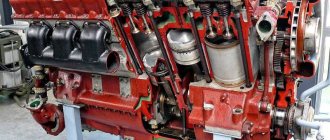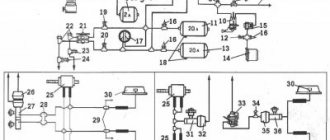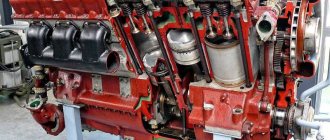The modern market is overflowing with a variety of goods. It can be not only of good quality, but also quite bad. And this is not surprising, because companies want to make good profits for less investment. It is worth noting that a modern motor differs not only in quality, but also in cost. In this article we will talk about the gas 53 engine, which is very popular.
The Soviet Union was able to produce a huge number of trucks. All of them are still used today, which is very good. It follows from this that the designers of that time tried to do it efficiently and conscientiously.
The first Gas 53 was designed in 1961. An internal combustion power unit was installed on it. Later, designers used V8-type power units. Thanks to this, it was possible to obtain very high power and torque.
Specifications
It is worth noting that in 1966, the ZMZ 53 power unit was installed on all Gas 53 trucks.
Download .xls file
xls
Download picture
Send by email
| PARAMETER | MEANING |
| Model | ZMZ 53 |
| Type | Gasoline, carburetor with V8 |
| Number of cylinders | 8 |
| Operating mode | four-stroke |
| Compression ratio of the power unit | 7.6 |
| Total engine capacity | 4.25 liters |
| Minimum power at 3200 rpm | 92 kW or 125 horsepower |
| Maximum torque | 294 N/m or 30 kilogram*force/meter |
| Fuel consumption at minimum speed | 286 grams/kilowatt hours or 210 grams per horsepower per hour |
| Fuel consumption per waste | 0.004 |
| Total weight of engines | 262 kilograms |
| Fuel used | A - 76 |
Installed on the following cars: Gas 53, Gas 11, Gas 20, Gas 71, Gas M1, Gas 66 and Gas 13.
Modifications of GAZ-53
Over the entire history of the car's assembly, several variants have been produced:
- 53F - produced from the autumn of 1961 to the winter of 1967. The airborne model featured a chassis with a forced engine with a power of 82 hp. The carrying capacity of the 51st reached 3-3.5 tons;
- 53 - the basic model, mass-produced in 1964-1965. The ZMZ-53 engine with a power of 115 horses allowed a speed of 85 km/h;
- GAZ version 53-a - a modernized series that could be loaded up to 4 tons, produced in 1965-1983;
- 53B - dump truck, produced since 1966;
- 53 N - production began in 1966 and ended in 1983. The army version provided an additional 105 liter fuel tank and a starting heater;
- 53-05 - flatbed truck for a 2-axle trailer, not mass-produced;
- 53-40 - a model with an extended chassis was supplied to the Kurgan Bus Plant and SemAR;
- 53-50 - manufactured for export to tropical countries;
- 53-70 - export variation for the temperate climate zone;
- 53-12 - produced from 1983 to 1993, distinguished by a 120-horsepower engine, a load capacity of 4.5 tons, and a speed of 90 km/h. The gearbox design did not have synchronizers;
- 53-19 - a car that ran on liquefied gas and had an internal combustion engine power of 105 hp. and speed 80 km/h. Produced in 1984-1992;
- 53-27 - version for compressed gas with a motor power of 100 hp. Produced in 1984-1992.
Based on the 53rd version, MPR-9924 was created. The mobile repair shop was equipped with a 53rd or 52-01 series chassis.
GAZ-53-27
Design
It is worth noting that many trucks were equipped with Gas 53 engines, which is very good. They had high efficiency and good technical potential. It is based on a simple carburetor running on gasoline fuel.
A small feature is the V-shaped arrangement of the cylinders. That is, they are located directly in the engine at a slight angle, which is very interesting. This stroke allows you to increase power and get good torque. As for the valves, they are located at the top.
The company's designers also used completely new cylinder heads with a high turbulence chamber and a screw exhaust valve. Thanks to this, Gas 53 engines received high efficiency and compression.
Also, do not forget that the power unit is equipped with a special exhaust gas recirculation system. This move will allow several times to reduce the emission of harmful substances into the atmosphere.
The engine also has a housing for a manual gearbox.
From the technical characteristics it is clear that as standard the driver will be able to receive a combined lubrication system:
- by spraying;
- under high pressure.
This move will increase the performance of parts and provide them with high-quality lubrication.
If we talk about the cooling system, then everything is very good. The fact is that the designers used a liquid system. It circulates a special fluid throughout all vehicle systems. Due to this, you will be able to move not only in warm weather, but also in very hot weather.
Modifications
Let's talk about the modifications of the Gas 53 engine themselves. In fact, there are not very many of them, since at that time they did not try to design in a variety of ways. Basically, everything was done on the basis of ZMZ 53, which was very popular. All sorts of changes implied some improvements in the operation and maintenance of the engine.
Currently you can find the following types:
- ZMZ 6606, having a piston stroke of 92 millimeters and a diameter of 80 millimeters. This is quite enough to produce 120 horsepower and a compression ratio of 7.6. As for the engine volume, it is 4.25 liters;
- Next comes ZMZ 511, the piston stroke is 92 millimeters and the diameter is 80 millimeters. As for the volume, it is relatively small, 4.25 liters. This is enough to produce 125 horsepower;
- ZMZ 523, having a volume of 4.68 liters and a power of 130 horses. The piston stroke is 92 millimeters and the diameter is 88 millimeters.
It is worth noting that the ZMZ 513 power unit belongs to a certain modification of the ZMZ 66 motor. As for other models and modifications, they have not received proper distribution.
All you have to do is list them:
- ZMZ 5233;
- ZMZ 5234.
They were installed only on grooves and some Gas models.
Historical emphasis
The history of the GAZ 53 internal combustion engine began back in 1959, when, by order of the Communist Party, they began to develop a motor that was supposed to replace the outdated GAZ 51. So, for the first time, the GAZ 53 car was equipped with power unit number 511 back in 1961, and this continued until 1993.
During the production of the car, quite a lot of modifications and experimental models were made. So, the engines installed were GAZ-53F, GAZ-53A, GAZ-53-12 and ZMZ-511. Also, engine models were developed that were not installed en masse, but found application in popular tuning. Among such representatives we can note the UAZ with the GAZ 53 engine and the Gazelle with the GAZ 53 engine.
In parallel with the 53rd, the Gorky Plant produced a hybrid - the GAZ 52. It was a six-cylinder engine, which was supposed to be something between the GAZ 51 and 53. The successor to the 53rd was the GAZ 3307, which was already equipped with MMZ and YaMZ power units. In 1997, the ZMZ-53 production line ceased to exist, and only one workshop remained for the production of spare parts for the engine.
Service
The internal combustion power unit has a fairly good working life and endurance. Due to this, the driver can drive his car for several years and not think about repairs or replacement of parts.
If you want to get an even larger resource, then you need to carry out all kinds of maintenance. This will not only maintain the technical characteristics of the power unit, but will also allow you to forget about financial costs:
- It is necessary to change the engine oil regularly, usually every 6 thousand kilometers traveled. Experts recommend using exclusively mineral type or semi-synthetics. The fact is that such oils are suitable for all Volgas and UAZs;
- It is also necessary to periodically tighten the cylinder head and the intake manifold mountings, the so-called spider. Experts recommend performing this procedure every 1000 - 2000 kilometers. If you have replaced the cylinder head gaskets or made repairs, immediately tighten all the bolts and belts. In other cases, the check is carried out every 30 thousand kilometers. I would also like to note that tightening is carried out exclusively on a cold engine;
- Check the water and coolant levels. This process is recommended to be done every day, especially in the summer. After all, if you don’t do this, problems may arise in the form of overheating of the power unit. All this will require a lot of money, which is very bad. This also applies to those who have a Gas 53 engine in a UAZ. The fact is that in this case the cooling system is a sore spot;
- Don't forget about adjusting the valves. Not only the performance of the engine, but also the amount of compression depends on this. It is worth noting that a high-quality gas distribution system does not require daily maintenance. As a rule, adjustment is carried out after replacing the cylinder head gaskets and when an unpleasant knocking noise occurs;
- Next, you should check the oil level in the sump of the internal combustion engine. This applies to drivers on the Volga and UAZ. Checking is necessary to ensure that all mechanisms receive their portion of high-quality oil and do not fail. If the level is insufficient, be sure to add engine oil. Otherwise the engine will fail. It is also necessary to check devices and sensors. They must show real numbers and not deviate;
- An external inspection of the car is also important. During this action, an oil leak may be detected. Experts say that leakage is the main problem of the ZMZ 53 engine.
If you want your vehicle to last for a long time, then carry out diagnostics and maintenance. It is necessary to immediately eliminate problems and all kinds of breakdowns.
It is also necessary to disassemble the power unit to get to the very heart. Assembly of the Gas 53 engine is carried out using a set of keys and special experience.
To change the oil, you must perform the following operations:
- Unscrew the neck cap;
- Remove the drain plug and let the old oil drain out;
- Screw the plug back;
- You need to be very careful while draining. The fact is that the oil is very hot and can burn the skin;
- Disconnect the filter and replace it with a new one;
- Fill some oil into the filter cavity;
- Fill with high-quality motor oil to the required level;
- Start the power unit and let it run for a while. This is necessary to ensure that the oil reaches all mechanisms;
- Check for leaks and oil level. If necessary, you can top it up.
Repair and operation
Repair of ZMZ-511 is carried out according to in-line breakdowns. Since the power unit is quite reliable, it can rightfully be considered a standard of endurance. But even the best engines have their service life and need to be repaired.
The GAZ 53 engine does not break down over trifles and this immediately leads to a major overhaul, which in many cases costs the same as a new engine. That is why many car enthusiasts practice repairing the GAZ 53 engine with their own hands. Let's consider the main technological process of overhauling the ZMZ-53 power unit.
What procedures need to be completed and completed:
- Engine washing.
- Disassembly. At this stage, the engine undergoes a total disassembly for spare parts in order to determine which parts are damaged, how much damage is caused to the block and crankshaft, the condition of the cylinder heads, piston group and cylinder heads. Also, minor parts are subject to diagnostics, namely: oil and water pumps, without fail the clutch and others.
- Diagnostic process. Only three main spare parts are involved here - the block (chambers where combustion occurs), the crankshaft (for maintainability) and the cylinder head (the condition of the gas distribution mechanism).
- The process of measuring and determining sizes. The crankshaft is bored. So, for this part there is a size table:
| Type of repair | Size |
| 1 | 0.05 mm |
| 2 | 0.25 mm |
| 3 | 0.50 mm |
| 4 | 0.75 mm |
| 5 | 1.00 mm |
As practice shows, a repaired crankshaft up to a size of 1.00 mm or more does not last long and tears under load.
- Boring and honing of the cylinder block. Here, there is also a table of maintainability dimensions:
| Repair | Size |
| Standard | 92.0 mm |
| 1 | 92.5 mm |
| 2 | 93.0 mm |
| 3 | 93.5 mm |
| 4 or more | Block sleeve (installation of sleeves of standard size 92.0 mm) |
Now, all old-style cylinder blocks are lined, where the engine can also be bored for a 92.5 and 93.0 mm piston system.
- Cylinder head bulkhead. This procedure includes the following operations: grinding and grinding valves, polishing camshaft cams, replacing valves and seals.
- When all the parts are prepared, the assembly of the power unit begins, where it takes on its original appearance.
- The last stage is painting and running-in, where oil will be added and the valve mechanism will be adjusted.
Malfunctions
| FAULTS | CAUSE |
| Knock of connecting rod bearing | Low oil level, low system pressure and general wear of parts |
| Increased fuel consumption | Oil leaks through seals and various connections |
| Knock of piston and upper bushing | The skirt and partition of the piston ring burst, the bottom burned out |
| Gasket burnout | Overheating of all parts |
| Exhaust valve burnout | Poor quality gasoline, oil on the valve and lack of clearance in the valve |
Tuning
Many people know that the Gas 53 truck is no longer produced in factories. And those models that are still moving on our roads need some improvements.
The fact is that the overall structure no longer has the original appearance it had in Soviet times. In this regard, craftsmen carry out all kinds of tuning, which concerns not only the appearance, but also the engine itself.
Engine tuning
The first step is to completely replace the old engine with a more advanced diesel engine (you can install, for example, a Volga engine).
The latter has many advantages:
- Consumes very little fuel;
- Quite a long service life, about 400 thousand mileage;
- It is very easy to maintain, change filters, oil and all kinds of belts. Assembling the Gas 53 engine is also not difficult;
- Very high efficiency.
If you decide to change the power unit, you will have to do the following operations:
- Re-weld the fastenings on the ramp;
- Replacing the fuel tank;
- Exhaust system replacement;
- Wiring;
- Design adapters and remake the driveshaft;
Maintenance
Maintenance of a car with a GAZ 53 engine is a fairly simple and not troublesome task, especially when it is installed on a GAZ 24. The engine, of course, consumes about 10 liters of oil, but its service life is about 250,000 km with regular maintenance .
So, it’s worth describing the main stages of power unit maintenance:
- TO-1 - changing the oil, fuel filter, tightening the valve mechanism.
- TO-2 - changing the oil, fuel filter, tightening the valve mechanism, replacing the fuel filter and valve cover gaskets.
- TO-3 - changing the oil, fuel filter, tightening the valve mechanism, replacing the timing kit, replacing spark plugs, high-voltage wires.
- TO-4 - changing the oil, fuel filter, tightening the valve mechanism, replacing the fuel filter, valve cover gaskets, cylinder head gaskets and pan.
The difference in mileage between maintenance is 12,500 km. With proper and regular care, the engine can last about 300,000 - 350,000 km. After a major overhaul, the technical maintenance chart changes and maintenance must be carried out more often.


